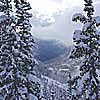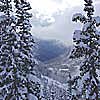No Snow? Go Moto.


The gun goes off, and u.s. ski Team member Daron Rahlves hammers his Honda CR250 off the starting line of a dirt-covered Washington race track. He bangs elbows and handlebars with a crush of riders. Welts rise on his arms as he’s pounded by clods of dirt. This ain’t no solo super G.
More than ever, snow-sports athletes are twisting the throttle in the name of dryland training. “It’s a good cross-over sport,” says Rahlves, a longtime rider who competed in last summer’s “Where the Snow Meets the Dirt” event at Washington’s Washougal MX Park. The race lured several of the nation’s best skiers and boarders including nationally ranked skiercross racer Berry Selley.
Skiers are known suckers for speed, but motocross has become particularly alluring. It’s got all the right ingredients: head-to-head, high-powered competition around a track that’s mined with washboard moguls and downhill-style jumps. You can practice line selection, cornering, and edge control. Call it moto-cross-training.
Downhill legend Franz Klammer swore by the workout his motorbike gave him. And the Mahre brothers were downright addicts. “You get out and ride hard for a half hour, you get off the bike-you’re a limp noodle,” says Steve Mahre, who, with brother Phil, spent summers avoiding official Ski Team training and, instead, gunned his dirt bike. Brant Moles and Olympic silver-medal aerialist Joe Pack both moto, and snowboarder Shaun Palmer rides the pegs so well he qualified for a pro event in 1998.
But dirt biking comes with a price. “It could be great cross-training; I just think it’s really dangerous,” says Matt Christensen, the U.S. Ski Team’s head aerial coach. In 2001, aerialist Jerry Grossi blew his Olympic hopes by cracking his femur on the track. Mahre blames dirt biking for ruining his knees, and Rahlves’ shoulder still hosts the plate from a 1997 throw. Still, he credits a turn to serious riding in 1999 for his two World Cup wins in 2000 and the super G crown at the 2001 World Championships.
“Mentally, I’ve got to find something that really pushes me (in the off season),” he says. “I need that constant sort of rush, the intensity.” Translation: It takes a few bugs in the gums to keep guys like Rahlves smiling-and winning.